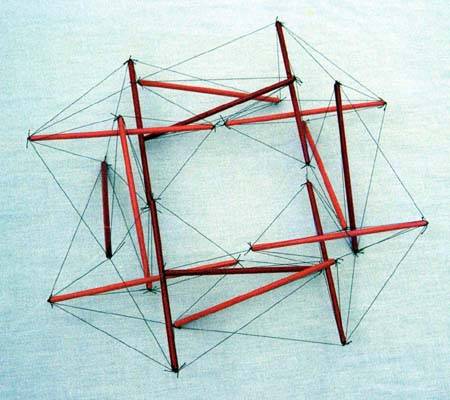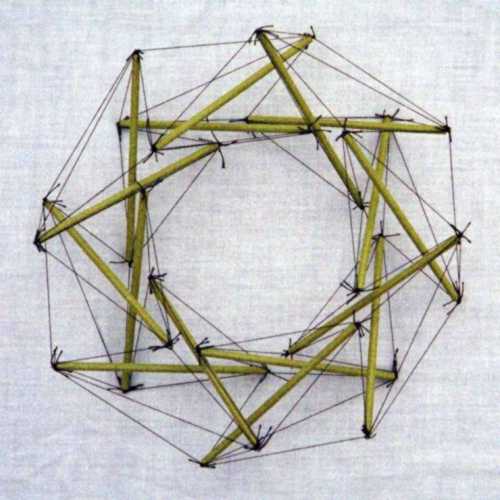

Here's a design for an eight-stage tensegrity torus based on Snelson's X-Module. I like the way half the X Modules are perpendicular to the ground and the others are parallel to it. This design was completed March 17, 2004. On April 14, 2008, after years of waiting to see if someone else might assemble this model, I put together a datasheet and decided to assemble it myself. I rescaled the datasheet on May 2, 2008, to use 200 mm struts rather than 130 mm struts. I also adjusted the weights in the model a bit to improve the clearances so they are comparable to those for the second version of the torus. I completed assembly of the model on May 31, 2008.
In the middle of assembling the model, I realized I needed to rethink my weighting scheme so it did not needlessly discard symmetry. For example, side1cp and side1bp (see datasheet) are related by symmetry, but in the model I assembled they were specified to have different tendon lengths. In my assembly process I did not duplicate this subtle asymmetry which must have contributed to some not-so-subtle asymmetries in the assembled model, and some tough moments in the assembly process. As a courtesy to you the reader and potential assembler, I have redone the computations to preserve these additional symmetries which a model builder naturally uses in putting things together, so you should have an easier time of things. As a bonus, the clearances in the model also improved a bit.
This model is available in the Tensegrity Viewers as "X-Module Torus 1".

On March 22, 2004, I came up with another weighting scheme for the tendons which resulted in a torus with a different configuration and better strut clearances. For the first configuration, the minimum strut-strut clearance was initially 0.160554 model units (after my adjustments of May 1, 2008, the minimum clearance was 0.201416). For the second configuration, the minimum strut-strut clearance is 0.203477 model units. The second configuration also has a rounder look to it (see rendering above) and exhibits more symmetry (see how values are duplicated various places in the chart below which didn't happen in the chart above). Without differentiating the tendon weights, the eight-stage torus seems to gravitate toward the first configuration and the twelve-stage torus (see rendering below) seems to gravitate toward the second one. Either of these tori can be urged to either configuration by changing the tendon weighting scheme. The second configuration's advantage in terms of strut clearances is important for the more tightly-curved tori. As the number of stages increases, this advantage disappears since the torus stages begin to resemble stages in an x-module column where this kind of configuration change doesn't matter. On January 31, 2008, after years of waiting to see if someone else might assemble this model, I put together a datasheet and decided to assemble it myself. I completed the model on April 10, 2008. The tendons make interesting zig-zag patterns in places.
This model is available in the Tensegrity Viewers as "X-Module Torus 2".


